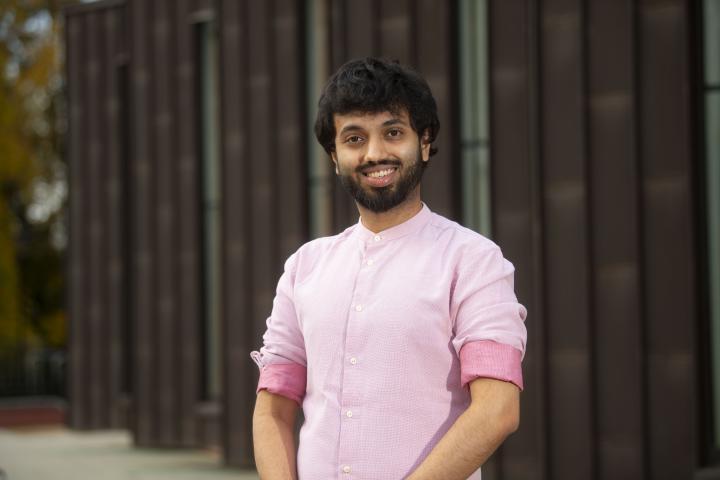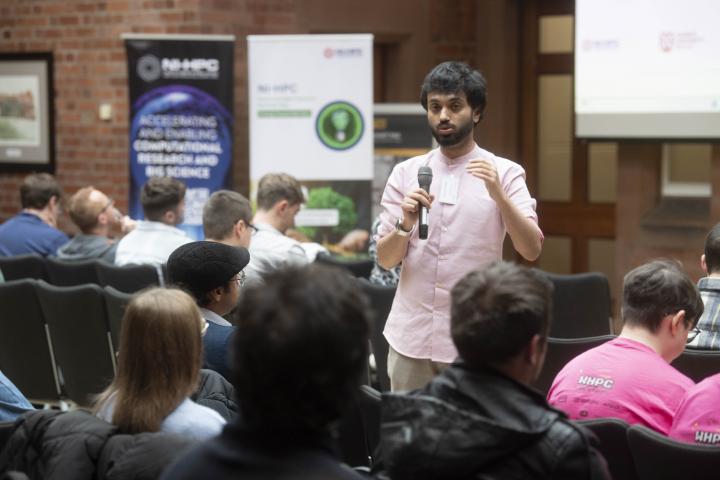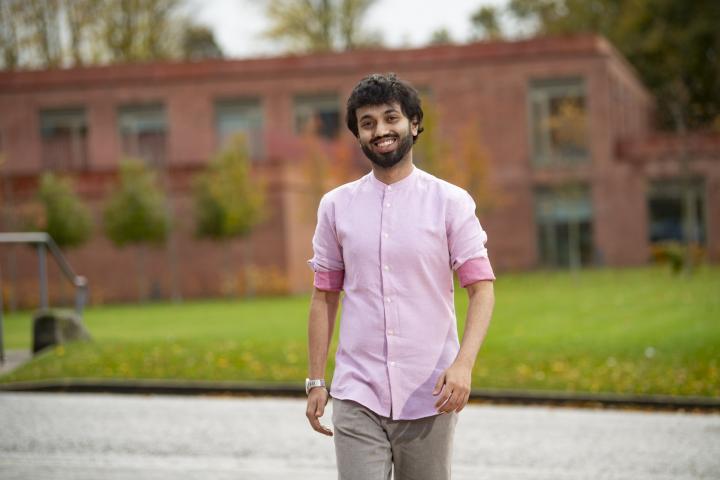
When Suhasish Basak fires up his artificial intelligence models on Ulster University's NI-HPC supercomputer, he can transform a simple sketch into a photorealistic garment design in under five minutes. What once took his standard laptop 80 long minutes now happens faster than brewing a cup of tea. This dramatic leap isn't just a technical achievement, it represents a fundamental shift in how fashion designers can work, waste less, and create more sustainably.
Thirty-one-year-old PhD researcher Suhasish from East India comes from a family tradition of textile craft, and now he’s aligning this with the raw computational power of Northern Ireland's high-performance computing infrastructure. His work points to how NI-HPC's Kelvin2 system can enable breakthrough research far beyond its traditional academic base, supporting visionaries who bring fresh perspectives to established industries.
READ MORE: Nesbitt: AI project delivering real time benefits to patients in Northern Ireland
Threads of Tradition
Suhasish’s drive to revolutionise fashion stems from generations of family history. "I come from a family in East India who have been weavers for generations," he says. "Our family name comes from that particular craft. I had a very good relationship with my grandfather, and he used to tell me about how things used to work in his time."
This connection to traditional craftsmanship anchors his technological ambitions in solving real-world problems. Where his grandfather worked with physical looms, Suhasish deploys algorithms. But the underlying mission remains creating beautiful, functional clothing while respecting both artistry and resources.

His journey to Ulster University's Belfast School of Art followed a path through manufacturing engineering, fashion technology, and business strategy. Nearly a decade in the industry - including roles as Chief Operating Officer for ethical fashion startups and contracts with global manufacturers for H&M and MANGO - gave him firsthand insight into some systemic inefficiencies.
"When I did my Master's in Southampton and started getting more knowledge about the retail side of the business, that's when I thought tech is the backbone of the industry," he says. This realisation led him to teach himself Python and pursue doctoral research in digital fashion, targeting one of the industry's most wasteful processes in the form of garment prototyping.
The Computational Breakthrough
Traditional fashion prototyping requires time-consuming physical sampling. Typically, this means cutting fabric, sewing samples, shipping prototypes globally for approval. Suhasish developed two AI pipelines using Stable Diffusion XL technology. One transforms text descriptions into realistic garment visuals, and another converts hand-drawn sketches into polished digital designs.
Initially running these models on his MacBook proved frustratingly slow. "Generating just one virtual design took 40 to 80 minutes, far too long for real-time experimentation," he says. Everything changed when he gained access to NI-HPC's Kelvin2 supercomputing cluster.
Using advanced memory-saving techniques, Suhasish optimised his models for the high-performance environment. The results were transformative. Design generation time plummeted to less than five minutes, enabling real-time creative feedback and live collaborative workshops with designers. This speed improvement unlocked practical applications previously impossible.
Competitive Innovation
When Suhasish spotted a Chinese company releasing a similar text-to-design tool, he responded creatively.
"They have already done the text bit, so to my mind it was nothing new - but what can I do about it?" he recalls. "So I was like, okay, let me try to incorporate sketches that a designer can put into the software, and get out a rendering that makes it at least a step higher than what they are doing, and bring a little more competitiveness."
This adaptive mindset reflects his broader philosophy about technological adoption in fashion. "If you don't use it, someone else is going to use it and someone else is going to have the competitive advantage," he says. "So why not do it?"
His pragmatic approach to innovation stems from hard-won industry experience. "I thought, you know what? This is where the rubber hits the road, and I have to learn [software] languages."
Industry Resistance and Mathematical Logic
Suhasish has witnessed firsthand the fashion industry's complicated relationship with technology adoption. "With the design department specifically, it's always been a challenge to integrate any new tech software, especially when you're working on hardcore design," he says. "They don't want to do it. They're like, just get someone else to do it or hire an intern."
Beyond academic research, Suhasish considers a practical commercial future addressing fundamental industry concerns about intellectual property and data privacy. His proposed "local AI" model could train bespoke systems exclusively on individual brands' design archives.
"We're trying to take AI, make it very local for an SME, train it on a particular set of data so that everybody has this power, but at the same time not compromising the privacy or copyright infringement issues," he says.
The problem with current global AI models is stark, as models like ChatGPT right now uses inputs to train its own model. His proposed solution offers SMEs something powerful.
"What the designers want is freedom to have a local model which is just trained on your data set, on your 100, 200, 500, 700 designs, whatever you have,” he says. “We train on your designs, and we give you the power in your company so that you don't have to be dependent on a very global data set."
Recognition and Future Ambitions
The research is fully funded by Ulster University's Vice-Chancellor’s Research Scholarship (VCRS) with the chief investigator Dr Janet Coulter and second supervisor Professor Justin Magee. Their work has garnered significant international attention. Suhasish has presented at three major conferences,
including the prestigious 93rd Textile Institute World Conference in Portugal, where he received a student bursary award. "Getting accepted was amazing, but to get an award as well was something else," he says.
The feedback from industry professionals has been encouraging, and one interaction particularly energised him.

"Someone just compared my product to Midjourney, and I was like, my God, that's something I would have never thought,” he says.
Suhasish’s research exemplifies NI-HPC's capacity to enable breakthrough innovation beyond traditional academic boundaries. The infrastructure didn't just accelerate his computations, it fundamentally changed what became possible within his research timeline.
"Without them, it wouldn't have been possible," he says of the NI-HPC support team. "It would have taken me another year if I didn't have the troubleshooting support."
The technical support proved crucial for someone transitioning from commercial software to high-performance computing environments. "I had never worked in an online environment before," he says. "I basically reached out to Tony and Jim and the other guys in the HPC, and they were really responsive."
READ MORE: Young Enterprise Big Market Celebrates 10 Years of Youth Entrepreneurship at St George’s Market
Looking ahead, Suhasish plans to integrate sustainability metrics directly into his AI models, collaborating with textile chemists to embed material biodegradability data into the design process. This would allow designers to understand environmental impact from the moment of digital conception.
Suhasish’s experience is further proof that world-changing innovation can emerge when traditional craft wisdom meets cutting-edge computational resources. His grandfather's loom may have been replaced by algorithms, but the essential mission of creating beautiful things efficiently and responsibly continues.
"Creating something wonderful is my primary goal, and I know I will be able to take it forward from here," he says.
Sync NI's Autumn 2025 magazine explores how Northern Ireland is moving AI from pilot to production
This issue features exclusive insights from industry leaders on real-world AI implementation, responsible adoption, enterprise infrastructure, and how data-driven innovation is transforming businesses across the region.
Read the Big Data Special Edition free online →
Stay connected with NI's tech community:
Subscribe to our newsletter – Get the latest tech news, job opportunities, and events delivered to your inbox
Visit Sync NI – Your daily source for Northern Ireland technology news